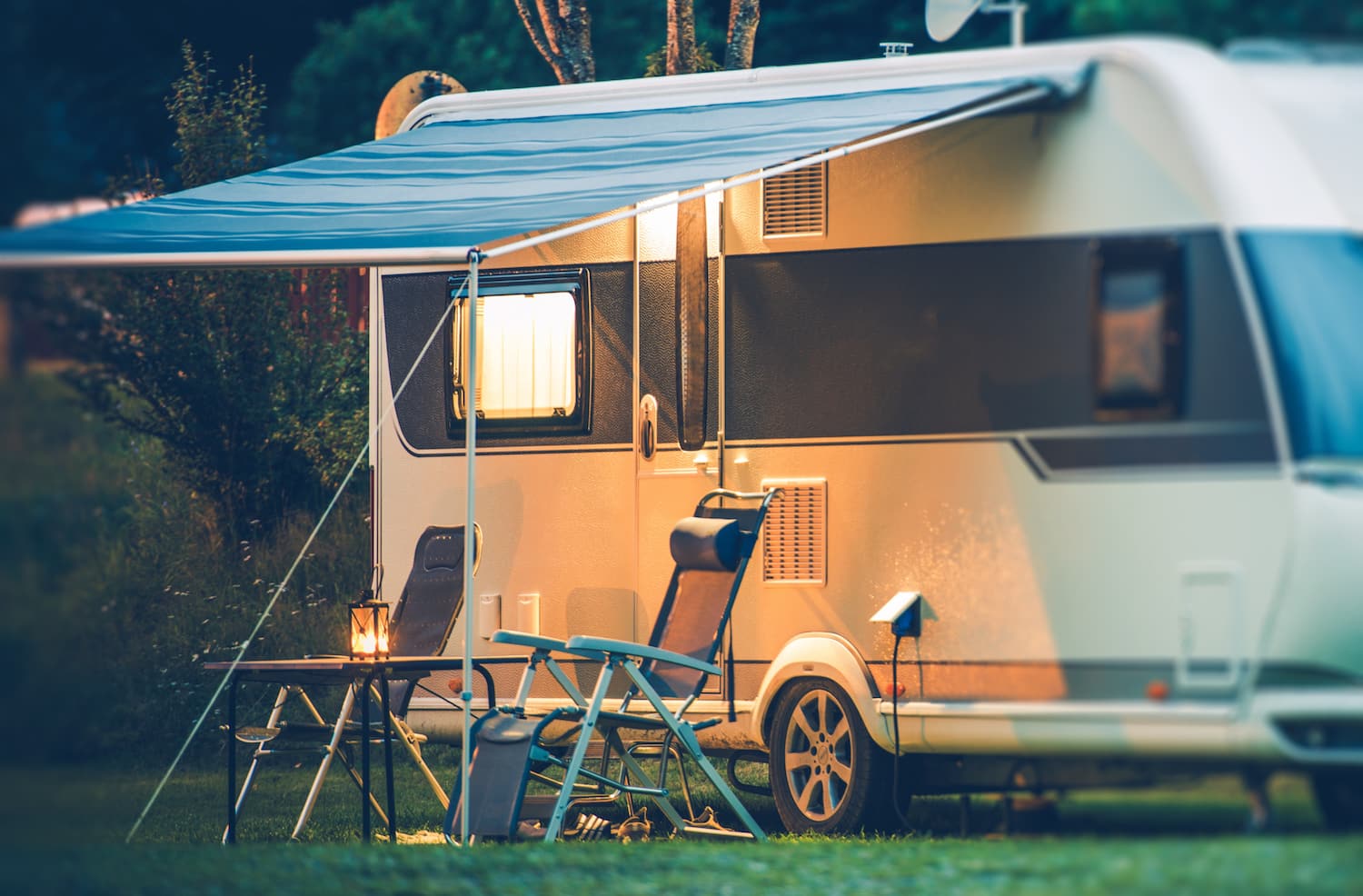Most new motorhomes and towable campers have at least one RV awning. You likely use yours several times on each camping trip, whether you need a little shade or want protection from light rain. But RV awnings don’t last forever, and whether yours breaks or you want to upgrade, you’ll need to know how to choose an RV awning replacement.
Our guide to RV awning maintenance covers the basics of cleaning and caring for your RV awning. But what if you need an entirely new awning? Check out this guide to RV awning replacement so you’re ready when it’s time to get rid of a damaged awning or upgrade to something better.
Why Replace An RV Awning?

RV awnings don’t last forever. While most will last years with proper use and maintenance, their location on your RV’s exterior means they are constantly exposed to rain, wind, sun, and other elements. From minor fabric tears to complete failures of the awning motor, there are many reasons to consider an RV awning replacement.
Additionally, you may just be tired of your manual awning and want to upgrade to an electric model. Or, you may be curious if you can remove your small awning and install a larger one. Upgrading your RV awning’s size isn’t always possible—due to other physical engineering constraints—but it can be a great way to add covered patio space outside your RV.
Technician Tip: Electric awnings can only be installed on RVs with compatible electrical systems. The awning must be connected to a power source, and your RV needs controls to operate it once installed. If you plan to install an electric awning on an RV that was previously equipped with a manual awning, schedule a service appointment at your local Camping World.
Types of RV Awnings
There are three basic types of RV awnings: manual, electric, and slide awnings—also known as slide toppers. Here are the main differences:
Electric RV Awnings

Power awnings feature a motor connected to a switch inside the coach, which is used for extending and retracting the awning.
Pros
- Easy, push-button operation
- Wind-sensitive safety features (some, not all)
Cons
- More expensive
- More mechanical components to maintain
Manual RV Awnings

Manual awnings require an extension rod that either pulls the awning open or cranks an internal cylinder to extend or retract the awning.
Pros
- More affordable
- Fewer mechanical components to maintain
Cons
- Harder to open
- No automatic safety features
Electric and manual RV awnings permanently mount to the side of your RV and typically range from 8 to 21 feet. The awning material can be canvas, polyethylene, or vinyl. Pitch adjustment is generally easy, although it varies based on the make and model. Today, most manufacturers install LED lights underneath the awning to provide extra lighting at the campsite.
Slide Toppers

RV slide-out awnings, also called slide toppers, are permanently attached to the top of slide-outs and roll out when the slide-out is extended.
Pros
- Protecting slide-out roofs from UV degradation
- Keeping leaves and other debris from accumulating and damaging slide-out seals and other components
Cons
- Not as standard as other RV awnings
- May require aftermarket slide topper installation
These awnings prevent leaves and other debris from accumulating on the slide-out roof. They also protect the slide-out roof from sun damage and reduce the amount of heat going into your RV slide-out.
How To Choose an RV Awning Replacement
Before purchasing an RV awning replacement, you’ll need to find an awning that fits your RV and can be installed securely. So, let’s discuss the factors to consider when choosing a new retractable RV awning.
Choose Your Awning Type

As previously mentioned, there are power and manual RV awnings. Most manufacturers have gone to electric RV awnings as a standard feature, but you may have a manual awning if you’ve bought or own an older RV. Luckily, it’s easy to determine between these two awning types—either you have power controls inside your camper for awning extension and retraction, or you don’t.
If you have an electric RV awning, you’ll have a button near the control panel of your RV that extends and retracts the awning. If you have a manual RV awning, there are no motors or buttons. You roll out the awning and secure it yourself with the awning arms.
When choosing an RV awning replacement, you must decide whether to install an electric or manual awning.
Ease of deployment is arguably the biggest factor when it comes to choosing a manual or an electric RV awning. Electric awnings might cost more, but they require little more than holding a button for 30-60 seconds until the awning is fully deployed. Opening a manual RV awning requires much more effort.
In addition, the best electric RV awnings now have safety features that automatically retract the awning if wind speeds exceed a pre-programmed threshold. While you should never leave your awning extended if your RV is unattended, a safety feature like this can prevent an unwanted RV awning replacement.
Once you’ve chosen your RV awning type, head outside to measure and follow the directions below.
Measure RV Awning Size

You must measure to ensure you select an awning that fits your RV. This process differs if you’re replacing an existing RV awning or installing a new one.
Replacing an Existing Awning
The easiest way to get the proper awning size is to measure your current awning and buy an RV awning replacement that matches its dimensions. Measure from the center of the forward arm to the center of the rear arm (as shown above). RV awning fabric will be slightly smaller than the arm-to-arm measurement, so avoid measuring the fabric itself when choosing an RV awning replacement.
Installing an Awning on an RV Without One
If you’re adding an awning to an RV without one, things are more complicated. For starters, you’ll need to decide where to place it. Most RV awnings are placed on the same side as the entry door (i.e. the camp side), but they must not impede the operation of the entry door, windows, compartment doors, other awnings, or slide-outs on that side of your RV.
Your awning choice will also depend on the size of your RV—the largest RV awnings are about 21 feet long. However, you won’t be able to install an awning of that size on a 20-foot class B camper van.
Your goal with location choice is to find locations where the RV’s construction allows you to secure the awning brackets. These locations will vary depending on whether you’re completing an RV awning installation on an aluminum vs fiberglass RV, for example. So, it’s a good idea to contact your RV’s manufacturer or work with a trained service team to identify these locations.
Once you choose a location, mark it and measure the area to determine your awning size options.
Measuring for RV Slide Toppers
When adding a slide topper—RV slide awning—measure from the outer edge of one slide-out f****e to the other so that the measurement includes the entire slide box. Your awning fabric should be this length.
The overall length of the entire RV slide topper will be longer because of the overhang on each side. As a result, you’ll purchase a topper that’s 5-10 inches longer than the fabric length. In addition, you’ll need to verify how far your slideouts extend. Slide-out depths vary, but this measurement is vital to choosing a replacement slide topper that will work for your RV.
Select Awning Materials

Another consideration is the awning material. If your awning arms are still in good shape, you should replace the awning fabric instead of the entire awning assembly. Most awnings use acrylic or vinyl fabric.
Acrylic fabric works great for most applications and is the most common. It offers good air circulation, handles all weather conditions well, and dries quickly. However, it isn’t fully waterproof and can stretch and sag over long periods of time.
Vinyl awning fabric is waterproof, scratch—and fade-resistant, and blocks harmful UV rays and other elements. However, vinyl attracts dirt and dust more easily and can be a hotbed for mold if not properly aired out.
Acquire Awning Support and Hardware
Finally, your camper must also have the proper framing and hardware to support an RV awning installation. Some awnings require a minimum distance between the awning rail and the entry door or slide-out room. Ensuring compatibility is critical before you purchase an RV awning replacement, and the best way to ensure your RV can support a new awning is to contact a Camping World Service Center.
Installing an RV awning without taking the proper steps to secure and seal it can result in structural failure, water leaks, and other damage. Entrust this job to a professional RV technician to avoid a costly DIY mistake.
Need Help With Your RV Awning Replacement?

If you don’t feel comfortable taking on an RV awning replacement yourself, contact our retail specialists and service team for awning repair, replacement, or upgrades. You don’t have to tackle a DIY project on your own. Our team is ready to help you choose the best option for your camping adventures!
If your awning is damaged, you’re ready to upgrade to an electric model, or you want a larger size, an RV awning replacement is just what you need. Hopefully, this guide will help you get started. But if you’re looking for other information about RV awnings in general, check out these helpful articles:
Have you recently purchased an RV awning replacement? What did you choose? Leave a comment below.
The post Choosing an RV Awning Replacement appeared first on Camping World Blog.



